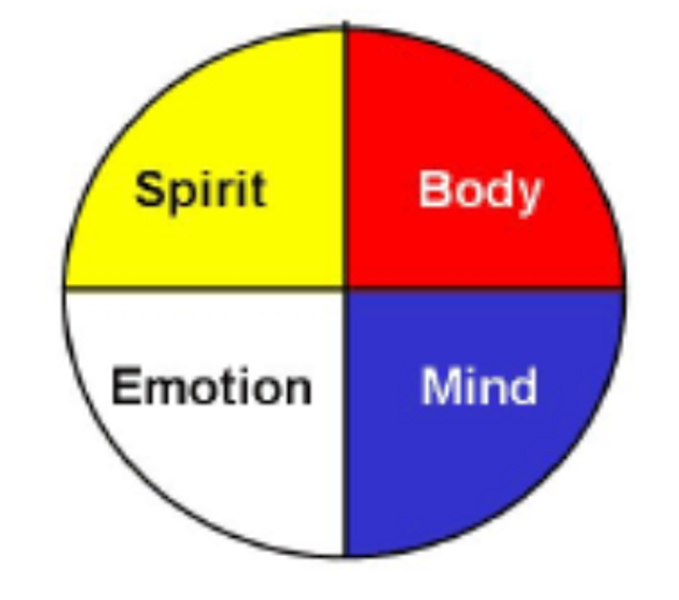Physical Activity and the Medicine Wheel: the Body
QOL Tree
Health Info
Physical Activity
Elders
ACSM
MW the Body
MW the Mind
MW Emotions
MW the Spirit
WHO
Get Started
Medicine Wheel: The Body and Physical Activity's Benefits

- Daily physical activity helps the body in many different ways
- This is true for all people (not just cancer survivors)
- Movement of our arms and legs helps the heart, lungs and bones get stronger
- Activity helps body organs and systems to work more efficiently
- It helps get rid of body waste
- It makes the brain function better
- It improves balance
- Find some type of movement and activity that you find enjoyable
- Walking with your family?
- Walking while listening to music or books or praying?
- Gardening?
- Dancing?
- Playing games like basketball?
- All are good for you
- Do something and do it every day
- It doesn't have to be the same activity
- Mix it up
- Do it alone!
- Do it with family or friends!
- But add some type of activity
- See which ones you enjoy that make you breathe harder
- Find some type of "play" of something that is fun
- Sitting on a swing in the park and swinging? Sure. Why not!
- Start with something small and not too difficult
- But, find something you can imagine yourself doing for a lot of years of feeling happy, good and strong again
Physical Activity Reduces:
- Heart disease risk
- Diabetes / insulin problems
- Blood pressure
- LDL ("bad" cholesterol) & triglycerides
- Increases HDL ("good" cholesterol)
- Severity of sleep problems
- Degenerative joint symptoms
- Female reproductive problems
- Stress
Health Benefits of Daily Physical Activity
- Improves the efficiency of how your body works (hormones, rid of wastes)
- Protects and builds lean bodies
- Improves your mind, emotions, spirit / health (the "mind", "emotion" and "spirit" parts of the Medicine Wheel all mixed together in a good way)
- Reduces risk of chronic / long-term diseases and causes of death
- Delays the aging processes
- Improves balance
- Strengthen muscles, or keep them from weakening
- Lower the risk of heart disease
- Lessen the risk bones will weaken
- Lessen the risk of blood clots
- Lessen dependence on others to perform daily tasks
- Improve self-esteem and lower risk of anxiety and depression (the "emotion" part of the Medicine Wheel)
- Lessen nausea
- Lessen fatigue
- Help control weight - Note that weight gain is a side effect for many breast cancer patients
Normal body weight
- Body mass index, or BMI, is a way to help you figure out if you are at a healthy weight for your height. BMI is a number based on your weight and height
- BMI is an estimate only
- Many conditions can affect BMI, such as someone who has a lot of muscle rather than a lot of fat tissue in the body will weigh more but is actually in better health
- Many times during cancer treatment, you will lose muscle because you do not feel well enough to take part in normal activities
- BMI can under-estimate body fat when you have lost muscle
- A good web site to help you calculate BMI is from the National Institutes of Health, Heart, Lung and Blood institute: nhlbi.nih.gov/health/educational/lose_wt/BMI/bmicalc.htm
- The higher your BMI, the higher your risk for certain diseases
- These include diseases like
- Cancer
- Heart disease
- High blood pressure
- Type 2 diabetes
- Gallstones
- Breathing problems
- To use the BMI table below, find the appropriate height in the left-hand column labeled Height. Move across to a given weight (in pounds). The number at the top of the column is the BMI at that height and weight. Pounds are rounded off.


Waist Circumference is also important

- If most of your fat is around your waist rather than at your hips, you're at a higher risk for health problems
- This includes
- Cancer
- Heart disease
- Type 2 diabetes
- This risk is greatest if your waist is larger than 35 inches for women or more than 40 inches for men
- To correctly measure your waist, stand and place a tape measure around your middle, just above your hipbones
- Measure your waist just after you breathe out
- According to the National Heart, Lung and Blood Institute, the table above gives you "a guess" for your disease risk
- You read this table by looking at BMI in the 1st column, then compare with your waist size
- If Mary has BMI for 33, and her waist size is 35 inches, her risk for diseases like colon cancer or diabetes is high
- Exercise can help reduce the size of her waist that also reduces her risks for these diseases